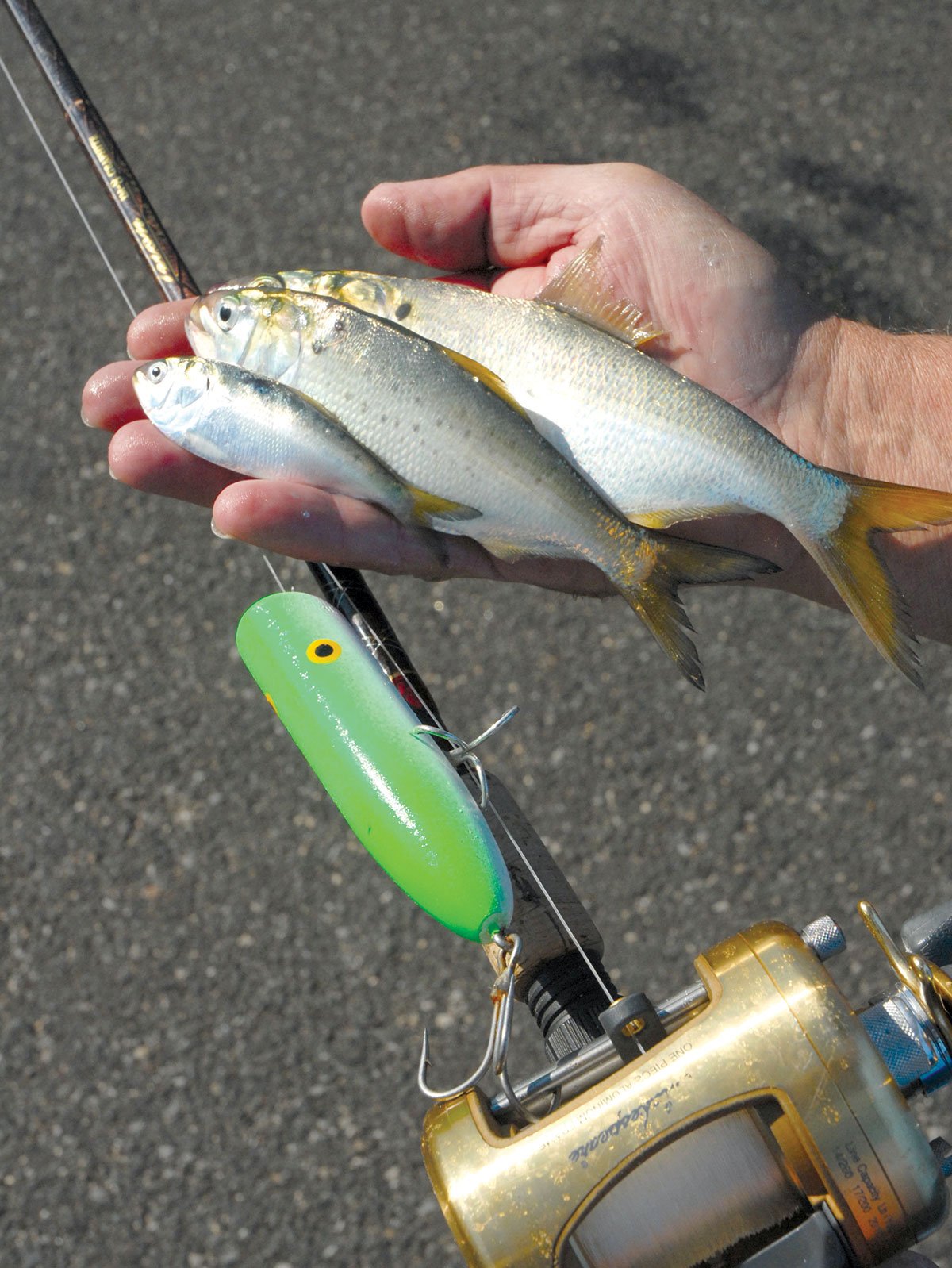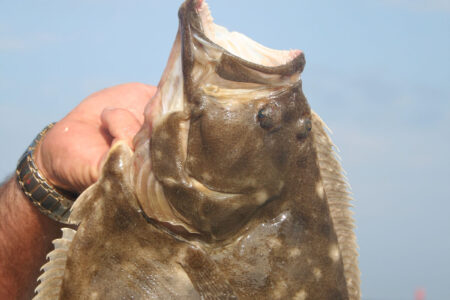
Many anglers don’t pay a lot of attention to bait and their migration patterns, yet a moment’s reflection reveals that our spring, summer and fall fishing patterns rely heavily on bait species and abundance. Specifics such as when they spawn, when they move (arrive and leave), and how successful a year class is, are crucial to success. Understanding the life cycles of various common bait species is essential as we formulate a fishing strategy and then adapt that strategy to bait changes throughout the season.
Sand Eels: Everyone knows that sand eels are those skinny baits that wiggle like eels and generally appear inshore when the water temperatures are in the 50s, and then scram when temps approach 70 degrees. That means sand eels are important spring and late fall baits for surf guys. In both the Mid-Atlantic and New England areas there are two types of inshore sand eel migrations. The first involves smaller (2 to 4 inches) young of the year sand eels that appear inshore anywhere from late March (south) to late May (north), while the second invasion occurs in late October or early November and usually involves larger adult sand eels (5 to 7 inches).
Many surf rats live by the bi-seasonal migration of sand eels. So, in spring they toss small bucktails with short rinds, 007 diamond jigs or spoon jigs with skinny tubes, and small tins such as West End Tackle’s Charlie Graves J1 (3/4 ounce) and J2 (1 ounce). At night, other lures come into play such as 3- to 5-inch RedFins, bombers, and SP minnows that are retrieved at an agonizingly slow pace. I always tell the surf anglers I mentor that “when you can’t stand it anymore because your retrieve is so slow, go slower.”
Other Critters Eat Sand Eels: Of course, not only do stripers, blues and weakfish eat sand eels, so do other critters such as squid. Now, should we surf rats be lucky enough to stumble on a shoal of sand eels fed upon by squid, we need to adjust our approach in order to cash in on larger fish that hunt the squid. For me, the best imitation of a squid is a bucktail and trailer. Sometimes shad also feed on sand eels and that allows us to use large plugs and hunt larger fish. Thus, the angler has a choice: focus on school bass with small lures or hunt big fish with large lures. Typically, an angler will catch numbers of school bass, but only a few larger fish. In this case, the size of the fish you chase boils down to style and personal preference.
Peanuts: In a perfect season, and we do get them once in a while, sand eels are abundant in spring holding fish right into early summer. Around 70 degrees sand eels migrate into deeper cooler water and pull stripers and blues with them. Large schools of stripers and blues can make a very good living on these sand eels and other baits in deep water through July and August. In a perfect season, peanut bunker will be abundant and about an inch or 2 by mid-August. So, just as the sand eel shoals spread out into deeper and deeper water, stripers and blues begin to get a whiff of peanuts as the tide ebbs from the harbors. Within days they follow the scent shoreward, find the peanuts, and begin a shallow water late summer feed that may last well into October.
Late summer and early fall are times to fish the harbors, creeks, and channels with small pencil poppers such as the Cordell 1-ounce model. However, this “perfect storm” season falters without successful bunker spawns. If the bunker spawn fails, the stripers and blues tend to slowly wander north until, in New England waters, they encounter cooler water that holds sand eels, herring, squid and mackerel. Even without lots of peanuts, these fish may make a comeback in autumn if there is enough other bait to attract them.

Snappers, Weakfish, Porgies: Typically, young of the year blues, weaks, etc. do not enter the food chain at the same time. Snappers are large enough to attract attention in July, but porgies and weakfish young won’t generally leave until early October. While snappers rumble about imitating their adult relatives, slashing at spearing and peanuts all summer, other young of the year fish are more reclusive. Young of the year weaks, sea bass and porgies tend to hold deep in sheltered waters away from sharp teeth and cavernous jaws. Here, they hide until they begin their fall migration.
Porgies, for example, make their migrating run in October and stripers and blues often gather up at the entrances to shelter water bodies ambushing them as they leave on outgoing tides. Since the porgies exit in waves, a run of fish could last for weeks. Much the same is true of weakfish except we haven’t enjoyed an abundant migration in decades. Whereas porgies make staggered moves to deep water and then exit to the continental shelf, weakfish tend to hug the coast on their way to the Carolinas. Although uncommon, small schools of weakfish are sometimes intercepted in the ocean trough, and gamefish will attack surface lures, tins and bucktails.
Mullet: I often ask myself, “What’s a mullet run?” We haven’t had a good run in decades. However, should it happen, blue and white poppers and pencil poppers rule the day.
Anchovies: Anchovies can present a challenge for anglers. Anchovy young of the year reach 3 to 5 inches by October and move into open water as they make a migratory push out of the estuary. Often anchovies are mistaken for other baits such as sand eels (because of the wiggle) and spearing (because of the silver stripe), but their pink translucent color and rounded snouts tip us off they are anchovies. When these are abundant, stripers and blues push huge pink offshore clouds towards the beach generating blitzes. As with all blitzes, there are days when almost any lure will catch fish, but there are days when the fish get fussy. I had that experience last fall. On one day I caught numbers of 25- to 30-inch stripers as well as monster blues on bucktails, poppers, pencil poppers and tins. The next day, expecting a repeat of yesterday, I was stymied by fussy fish. Oh, the bait was there: running the shore in pink rivers, and thousands of stripers glided right and left only a few feet in front of me. Although I caught a few fish, the operative word is “few” and the day was frustrating. This was a fussy day and a day for the fly guys who caught the lion’s share of the fish. They allowed their flies to settle to the bottom a few feet offshore, and when the bass moved by, they lifted and twitched the fly-BAM! How might a spin guy have adjusted? If I had any inkling that it would be a fussy day, I would have brought 4-inch skinny tailed soft plastics such as Zoom or Bass Assassin and rigged them on an unweighted 5/0 hook and used the same presentation as the fly guys. But, who knew?
The discussion in the previous paragraph raises a very important point about bait and its effects on successful surf fishing. Predators always key on food that’s most abundant. That’s why it’s impossible for predators to bring about a steep decline in the size of a population of another species. As abundance declines, the ratio between calories gained and calories spent to catch food declines until it is unacceptable. So, a lack of weakfish means that most of the young of the year escape unmolested, while porgies that have been enjoying annual huge spawns are targeted. Similarly, in the 1970s and ‘80s when bluefish spawns were immense year after year, snappers were often targeted but are rarely keyed on today because of fair to poor spawns.
In the 1980s one of my favorite patterns was the “snapper pattern.” Key to the pattern was huge schools of snappers feeding on small baits such as spearing and peanuts. School stripers as well as larger fish cruised under the melee waiting for an oblivious snapper to turn toward the bottom or charge along at the surface. The predators hid amongst cover such as extensive reedy areas, scattered grass islands and areas with scattered rocks or boulders. My lure of choice was the Cordell C10 RedFin because it mimicked a wounded snapper. Alas, there hasn’t been a snapper pattern in many seasons, but I have been enjoying the October porgy pattern. Adapt to the reality!
Adult Bunker: Although many anglers seek out and work around adult bunker schools with lures, I’m usually not one of them. Yes, I have had good days when a variety of surface lures produced both monster blues and big bass, but more times than not I’ve been frustrated watching fish crash bunker without a hit. I prefer more predictable patterns such as those described above, but for those who get worked up about fish crashing adult bunker, here’s a hint. Although the appearance of adult bunker will be erratic, success is much more likely along the oceanfront than in quiet water, and large plugs will attract more attention than small ones.
Large Fall Sand Eels: For me the best fall run bait is large sand eels. The reasons reflect how the sand eels live. They aren’t strong swimmers so they don’t run down a beach or move swiftly far offshore to escape predators. Their signature escape is to burrow in the sand, so they’ll be in the same stretch of beach for runs that last for weeks and not days.
The only deterrence to success are light winds and a flat calm ocean that allows the skinny critters to stay buried. Crashing waves, on the other hand, disturb the sand and lifts the sand eels. Suddenly, as a result of the turbulence, sand eels find themselves in the water column instead of the sand and become easy targets.
This pattern has three elements. First, large sand eels need to be abundant. Second, they must move into the beach trough (probably because their plankton food is abundant there) and third the water temperature needs to be “right.” Add some waves, a decent beach structure, and migrating stripers and blues and you have the makings of some very hot action on bucktails with pork rind, tins and tubes, and a variety of typical night lures in the dark. However, be warned, typically the day bite is better than the night.
Adapting to bait – both the species and the size – as the season moves on as relentlessly as the tide, can produce big dividends compared to the stubborn commitment to a favorite lure over the course of the season.



